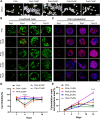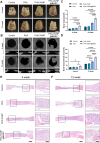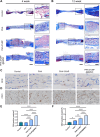Injectable Polyhydroxyalkanoate-Nano-Clay Microcarriers Loaded with r-BMSCs Enhance the Repair of Cranial Defects in Rats
- PMID: 39735323
- PMCID: PMC11681809
- DOI: 10.2147/IJN.S498950
Injectable Polyhydroxyalkanoate-Nano-Clay Microcarriers Loaded with r-BMSCs Enhance the Repair of Cranial Defects in Rats
Abstract
Purpose: Successful regeneration of cranial defects necessitates the use of porous bone fillers to facilitate cell proliferation and nutrient diffusion. Open porous microspheres, characterized by their high specific surface area and osteo-inductive properties, offer an optimal microenvironment for cell ingrowth and efficient ossification, potentially accelerating bone regeneration.
Materials and methods: An in vitro investigation was conducted to assess the physicochemical properties, porosity, and biocompatibility of PHA-nano-clay open porous microspheres. Subsequently, PHA-nano-clay microspheres loaded with rat bone marrow mesenchymal stem cells were implanted into 5 mm cranial defects in rats for a duration of 12 weeks and were evaluated through histological and immunohistochemical analyses.
Results: The incorporation of nano-clay into PHA resulted in improved mechanical properties of the porous scaffolds. Furthermore, cell adhesion, viability, and morphology on the scaffolds were maintained. The PHA-3% nano-clay open porous microspheres effectively enhanced the repair of cranial defects compared to the control group, without recurrence or complications.
Conclusion: Porous PHA-nano-clay microspheres, with their high specific surface area, biodegradability, and osteo-inductive properties, can be utilized as a bone-filling material for improved bone defect repair through cell delivery. In particular, PHA-3% nano-clay open porous microspheres exhibit promising therapeutic potential in the repair of cranial defects.
Keywords: P34HB; bone-filling biomaterial; cranial defects; open porous microspheres; osteo-inductivity.
© 2024 Ci et al.
Conflict of interest statement
The authors report no conflicts of interest in this work.
Figures







Similar articles
-
A Micro-Ark for Cells: Highly Open Porous Polyhydroxyalkanoate Microspheres as Injectable Scaffolds for Tissue Regeneration.Adv Mater. 2018 Aug;30(31):e1802273. doi: 10.1002/adma.201802273. Epub 2018 Jun 19. Adv Mater. 2018. PMID: 29920804
-
Injectable Cell- and Growth Factor-Free Poly(4-hydroxybutyrate) (P4HB) Microspheres with Open Porous Structures and Great Efficiency of Promoting Bone Regeneration.ACS Appl Bio Mater. 2021 May 17;4(5):4432-4440. doi: 10.1021/acsabm.1c00188. Epub 2021 Apr 23. ACS Appl Bio Mater. 2021. PMID: 35006855
-
P34HB electrospun fibres promote bone regeneration in vivo.Cell Prolif. 2019 May;52(3):e12601. doi: 10.1111/cpr.12601. Epub 2019 Mar 21. Cell Prolif. 2019. PMID: 30896076 Free PMC article.
-
Mesenchymal stem cell-seeded porous tantalum-based biomaterial: A promising choice for promoting bone regeneration.Colloids Surf B Biointerfaces. 2022 Jul;215:112491. doi: 10.1016/j.colsurfb.2022.112491. Epub 2022 Apr 6. Colloids Surf B Biointerfaces. 2022. PMID: 35405535 Review.
-
Biological effects, properties and tissue engineering applications of polyhydroxyalkanoates: A review.Int J Biol Macromol. 2025 Mar;293:139281. doi: 10.1016/j.ijbiomac.2024.139281. Epub 2024 Dec 28. Int J Biol Macromol. 2025. PMID: 39736299 Review.
Cited by
-
Hydroxyapatite Scaffold and Bioactive Factor Combination as a Tool to Improve Osteogenesis, In Vitro and In Vivo Experiments Using Phage Display Technology.Int J Mol Sci. 2025 Jul 22;26(15):7040. doi: 10.3390/ijms26157040. Int J Mol Sci. 2025. PMID: 40806172 Free PMC article.
References
MeSH terms
Substances
LinkOut - more resources
Full Text Sources

